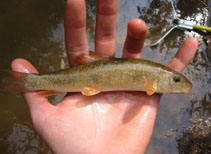| Family: |
Catostomidae (Suckers), subfamily: Catostominae |
| Max. size: |
65 cm TL (male/unsexed); max.weight: 2,940.0 g; max. reported age: 12 years |
| Environment: |
demersal; freshwater; brackish |
| Distribution: |
North America: throughout most of Canada to the Atlantic Coast, south through North Carolina to New Mexico in the USA, becoming less common in the southern High Plains. |
| Diagnosis: |
|
| Biology: |
Inhabits a wide range of habitats, from rocky pools and riffles of headwaters to large lakes. Usually occurs in small, clear, cool creeks and small to medium rivers. May be found at a depth greater than 45 m (Ref. 1998). Moves to shallower water near sunrise and sunset to feed. Fry (1.2 cm in length) feed on plankton and other small invertebrates; bottom feeding commences upon reaching a length of 1.6-1.8 cm. Preyed upon by birds, fishes, lamprey, and mammals (Ref. 1998). Flesh is white, flaky, and sweet (Ref. 1998). |
| IUCN Red List Status: |
Least Concern (LC); Date assessed: 26 October 2011 Ref. (130435)
|
| Threat to humans: |
harmless |
Source and more info: www.fishbase.org. For personal, classroom, and other internal use only. Not for publication.

